Metal Gear Solid 1 Do Solidiers Comentary Change on Account of How Well You Do
This article is virtually the video game, Metal Gear Solid . You may be looking for Metal Gear: Ghost Babel, which was released outside of Japan equally Metal Gear Solid .
Metal Gear Solid (メタルギアソリッド , Metaru Gia Soriddo ? , ordinarily abbreviated equally MGS or MGS1 ) is a stealth activity video-game directed past Hideo Kojima. The game was developed by Konami Computer Entertainment Japan and kickoff published in 1998 for the PlayStation.[1] Information technology was well-received critically and commercially, aircraft more than six million copies (being the eighth best-selling game on the PlayStation),[2] and scoring an average metascore of 94 out of 100 on Metacritic.[3] It is widely considered to be one of the greatest and most of import games of all time,[four] [5] and is heralded equally the game that made the stealth genre popular.[6] It is the third canonical title released in the Metallic Gear series, being a sequel of Metal Gear 2: Solid Ophidian.
The commercial success of Metal Gear Solid prompted Konami to enhance and re-release the game for the PlayStation and Windows PC under the title Metal Gear Solid: Integral;[6] a remake, Metallic Gear Solid: The Twin Snakes was later released for the Nintendo GameCube.[vii]
Contents
- 1 Plot
- 1.ane Bandage
- two Theme
- 3 Gameplay
- 4 Development
- 5 Music
- 6 Release history
- six.1 Original version
- 6.2 Expanded version
- 6.two.i Integral
- 6.2.2 The Twin Snakes
- six.3 Digital Graphic Novel
- 6.4 Other re-releases
- half-dozen.5 Possible second remake
- 6.6 References in other games
- 7 Reception
- viii In other media
- eight.1 Strategy guide
- 8.two Radio drama
- eight.3 Comic
- 8.4 Novelization
- 8.4.one Raymond Benson
- 8.iv.2 Hitori Nojima
- ix Legacy
- 10 Gallery
- 10.ane Promotional material
- 10.two Packaging
- 10.3 Demos
- 10.iv Books
- 10.5 Videos
- 10.6 Merchandise
- ten.7 Paraphernalia
- 10.eight Posters & wallpaper
- 10.9 Trailers
- 11 External links
- 12 See also
- 13 References
- 14 External links
Plot
| Metal Gear chronology |
|---|
| Metal Gear Solid 3: Snake Eater (1964) Metal Gear Solid: Portable Ops (1970) Metal Gear Solid: Peace Walker (1974) Metal Gear Solid 5: Footing Zeroes (1975) Metal Gear Solid V: The Phantom Pain (1984) Metal Gear (1995) Metal Gear 2: Solid Snake (1999) Metal Gear Solid (The Twin Snakes) (2005) Metallic Gear Solid ii: Sons of Liberty (2007/2009) Metal Gear Solid 4: Guns of the Patriots (2014) Metal Gear Rising: Revengeance (2018) |
During a training mission in late February 2005 on Shadow Moses, a remote island off the declension of Alaska containing a nuclear weapons facility, FOXHOUND and the Adjacent-Generation Special Forces rebelled against the United States Government, under the command of Liquid Snake. Their target was the avant-garde weapon system Metal Gear REX, a gigantic robotic weapons platform with worldwide nuclear strike capabilities. Their demand was the body of the greatest soldier who ever lived, Big Boss, which, through gene therapy, they could utilise to create an army of ultimate soldiers.
With the safety of the entire world at stake, at the asking of the Secretary of Defense, Colonel Roy Campbell, the old commander of FOXHOUND, summoned Solid Serpent out of retirement for one last solo covert operation to stop Liquid.
- For a total plot summary, encounter Shadow Moses Incident.
Cast
Near of the English vox actors were credited under pseudonyms since they did not know if the project was supported by the Screen Actors Club. The only ones who used their real names were David Hayter (Solid Ophidian), Doug Rock (Psycho Mantis), and Scott Dolph. In the German version, Nastasha Romanenko's voice actress, Birgit Khan, is incorrectly credited equally "Brigit Khan."
| Grapheme | Vocalisation actor | |||||
|---|---|---|---|---|---|---|
| English language (pseudonyms) | Japanese | German | French | Italian | Spanish | |
| Solid Snake | David Hayter (Sean Barker) | Akio Ōtsuka | Stephan Grothgar | Emmanuel Bonami | Alessandro Ricci | Alfonso Vallés |
| Liquid Snake / Master Miller | Cam Clarke (James Flinders) | Banjō Ginga | Michael Hulsmann | Stéphane Cornicard | Andrea Pirovan | Riki Coello |
| Meryl Silverburgh | Debi Mae West (Mae Zalder) | Kyoko Terase | Britta Gartner | Framboise Gommendy | Ilaria D'elia | Ana Maria Camps |
| Naomi Hunter | Jennifer Hale (Carren Learning) | Hiromi Tsuru | Gertrud Thoma | Linda Sans | Jessica Juffré | Meritxell Ane |
| Hal Emmerich | Christopher Randolph (Christopher Fritz) | Hideyuki Tanaka | Erich Redmann | Nicholas Mead | Massimo Marinoni | Quique Hernandez |
| Roy Campbell | Paul Eiding (Paul Otis) | Takeshi Aono | Michael Mellinger | Philippe Smolikovski | Angelo Cola | Vicente Gil |
| Mei Ling | Kim Mai Guest (Kim Nguyen) | Houko Kuwashima | Nicole Kehrberger | Vanessa Seydoux | Laura Farina | Noemi Bayarri |
| Gray Fox | Greg Eagles (George Byrd) | Kaneto Shiozawa | Sebastian Michael | Olivier Deslandes | Massimo Marinoni | Jose Javiar Serrano |
| Nastasha Romanenko | Renee Raudman (Renee Collette) | Eiko Yamada | Brigit Khan | Cécile Hopkins | Benedetta Ferraro | Marta Estrada |
| Revolver Ocelot | Patric Zimmerman (Patric Laine) | Kōji Totani | Wolf Kähler | Philippe Smolikovski | Giancario Ciccone | Javier Amilibia |
| Vulcan Raven | Peter Lurie (Chuck Farley) | Yukitoshi Hori | Werner Kastor | Pierre Maubouché | Joaquin Gomez | |
| Psycho Mantis | Doug Stone | Kazuyuki Sogabe | Stefan Boje | Philippe Monnet | Ciro Carraro | Francesc Rocamora |
| Sniper Wolf | Tasia Valenza (Julie Monroe) | Naoko Nakamura | Nichola Thomasoni** | Framboise Gommendy | Luciana Icci | Ana Orra |
| Donald Anderson / Decoy Octopus | Greg Eagles (George Byrd) | Masaharu Satō | Wolf Kähler | Stéphane Cornicard | Andrea Pirovan | Javier Amilibia |
| Kenneth Baker | Allan Lurie (Bert Stewart) | Yuzuru Fujimoto | Peter Zander | Daniel Pageon | Luigi Chiapinni | Paco Alborch |
| Jim Houseman | William Bassett (Fredrick Bloggs) | Tomohisa Asō | Wolf Kähler | Philippe Monnet | Javier Amilibia | |
| Johnny Sasaki | Dean Scofield (Dino Schofield) | Naoki Imamura | Stefan Boje | Olivier Deslandes | Quique Hernandez | |
| Genome soldier A | Doug Stone | Masaya Takatsuka | Sebastian Michael | |||
| Genome soldier B | Peter Lurie (Chuck Farley) | Naoki Imamura | ||||
| Enemy soldier | Dean Scofield (Dino Schofield) Scott Dolph | |||||
| Computer vocalisation | Tasia Valenzia (Julie Monroe) | Naoko Nakamura | Nichola Thomasoni | Cécile Hopkins | Meritxell One | |
- ^ This credit just appears in early on demo versions of the game and in the back of some versions of the user manual under Bandage and Credits in the European version. Hayter did not use a pseudonym in the game credits.
Theme
Genetics is the theme behind this game, or the idea of nature vs. nurture. In the catastrophe, Liquid has an opportunity to kill Snake merely the FOXDIE virus gets him offset. Since Liquid and Ophidian are identical, it is unsaid that Snake will eventually be killed by FOXDIE as well. The thought of genes expands beyond the family tree with the Genome Army. Due to being genetically-enhanced with Big Boss' "soldier genes", they are as well a part of Big Boss' "legacy."
Some other theme is how genetic technology can be used in a number of ways and whether or not it is skillful or bad is a matter of personal opinion.[8]
Gameplay
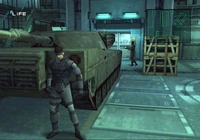
Solid Snake hiding from a guard.
Despite a transition to 3D, Metal Gear Solid's gameplay remains like to Metallic Gear 2. The player must navigate Solid Ophidian through the game's areas without existence detected.[ix] Detection will prepare off an alarm, which draws armed enemies to his location.[ten] To return to a lower alert setting, the player must hide, and remain undetected by the enemy until the timer reaches cypher.[eleven]
To remain undetected, the player must make utilize of Snake's abilities and the environment, such as crawling nether objects, using boxes as cover, ducking or hiding around walls, and making noise to distract the enemy. These are carried out in the third-person camera view; which slowly changes its bending to give the player the best strategic view of the area possible, and an on-screen radar, which displays enemy personnel and their field of vision.[12] Snake is armed with many items and gadgets, such every bit thermal goggles and a cardboard box for apply as a disguise, as well as numerous weapons.[xiii] This emphasis on stealth promotes a less violent form of gameplay, as firefights against large numbers of enemies who posses superior equipment volition probable result in heavy damage and often decease for the protagonist, especially early on in the game when less strong guns are bachelor.[14]
The game contains plot-progressing cutscenes and radio conversations (known as the Codec), too equally encounters with the bosses. To progress, the actor must observe the weaknesses of these enemies in gild to defeat them. This is where the thespian will most often apply the game's weapon-prepare, ranging from pistols and assail rifles to rocket launchers and grenades. Game controls and play strategies can too be accessed via the Codec, where advice is delivered from Snake's back up crew; for example, the support squad may chastise Serpent for not saving his progress often enough, or explain his combat moves in terms of which buttons to printing on the gamepad. Completion of the game provides the player with a statistical summary of their performance, and a codename based upon information technology, typically the common name of an animal.[15]
In a kickoff for the Metal Gear series, the player can partake in VR Training, a training mode in which they tin can practice hiding techniques, weapons use, and sneaking. In improver to the stealth gameplay, there are fix-piece sequences that entail firefights betwixt the histrion and the enemy from the tertiary-person and first-person perspectives.[11]
Development
Hideo Kojima originally planned to release the third Metal Gear game, Metal Gear three, for the 3DO Interactive Multiplayer in 1994.[16] While producing the 3DO version of his run a risk game Policenauts, concept art by illustrator Yoji Shinkawa of Solid Serpent, Meryl Silverburgh, the latter also appears in Policenauts, and the FOXHOUND team, were included in the Policenauts: Airplane pilot Disk preceding the release of the full 3DO game in 1995.[17] However, due to the failing support for the 3DO, development of the game was shifted to the PlayStation shortly after the 3DO version of Policenauts was released. Role of the reason why Kojima wanted to do a sequel to Metal Gear was because it was his first game when he joined Konami, so it had a special place for him, also as exploring farther the concepts of stealth that Metal Gear brought to low-cal, with the PlayStation giving him the opportunity to do and so.[18] The plot point of a renegade American special forces unit of measurement taking control of a nuke on Usa soil was originally meant to be the plotline for Metal Gear 2: Solid Snake, although Kojima had nixed it during that game'due south evolution due to believing it to be as well unrealistic. He ultimately used it for Metal Gear Solid largely due to the growing changes in social club in the aftermath of the Common cold War.[19]
Kojima decided to re-title the game as Metal Gear Solid. He did this because he believed that the first two MSX2 games weren't well known at the fourth dimension.[15] In fact, he initially intended to remake Metallic Gear birthday before ultimately deciding to do a sequel instead.[18] Co-ordinate to Kojima, the "Solid" in the title has three meanings: a reference of Solid Snake, the game'due south use of 3D graphics, and Konami's rivalry with Square.[xx] In addition, he too stated that, while similar in some respects to the so-contempo release of the Capcom game Resident Evil in terms of tension-related gameplay, he indicated that Metal Gear Solid would give a different take to the heart-racing gameplay. He besides indicated that prior projects of his such as Policenauts and Snatcher acted as an inspiration for the more drama-focused aspects of the game.[18]
Evolution for Metal Gear Solid began in mid 1995[21] with the intent of creating the "best PlayStation game ever."[22] Developers aimed for accurateness and realism while making the game enjoyable and tense. In the early on stages of evolution, a SWAT squad educated the developers with a demonstration of vehicles, weapons and explosives.[22] Kojima stated that "if the role player isn't tricked into assertive that the world is real, then there'south no point in making the game." To fulfill this, adjustments were made to every detail, such every bit individually designed desks.[23]
Kojima created the characters of Metal Gear Solid; modifications and mechanics were made by conceptual artist Shinkawa. The characters were completed by polygonal artists using pencil drawings and clay models by Shinkawa.[24] The designers would sometimes use Lego pieces to put the levels together.[25]
Kojima wanted greater interaction with objects and the surround, such as allowing the histrion to hide bodies in a storage compartment. Additionally, he wanted "a full orchestra right next to the player"; a system which fabricated modifications to the currently playing runway, instead of switching to another pre-recorded runway. Although these features could non be achieved, they were implemented in Metallic Gear Solid two: Sons of Liberty.[26]
Metal Gear Solid was revealed to the public at E3 1997 as a brusque video. It was later playable for the first time at the Tokyo Game Show in 1998 and officially released the same twelvemonth in Japan with an extensive promotional campaign.[27] [22] Television and magazine advertisements, in-store samples, and demo giveaways contributed to a full of The states$eight meg in promotional costs.[28]
During evolution, to promote the game'due south release in various gaming magazines, Shinkawa developed a two-page comic promoting the game. It featured Solid Snake having an encounter with Revolver Ocelot, telling the latter to go to Hell every bit he points his gun at him. Ocelot then replies that Hell if anything is already coming to their current location. Serpent and so leaves, although not before sarcastically laughing and telling Ocelot to get stuffed every bit the narration quizzically asks nigh the Gates of Heaven. Meanwhile, Jim Houseman is discussing with ii men every bit the narration asks what Metal Gear is, with Mei Ling request if Serpent is okay.
Nearing its North American release, ane of the first commercials depicted a soldier doing bones, kindergarten-level "rigorous training" for a mission that was supposed to be top surreptitious. When the accompanying soldier questions whether the tests are too piece of cake for the soldier, the commander reminds him that he's prepping him for a suicide mission. The commercial then ends with Snake apparently being killed by Vulcan Raven's tank. The Metallic Gear Solid Facebook page, when uncovering this advertisement in June 29, 2012, pointed out that, had Ophidian'southward preparation been anything like the soldier in the commercial, he most likely would never have made information technology across the docking area of Shadow Moses.[29]
Music
- Main article: Metal Gear Solid Original Game Soundtrack
Metal Gear Solid's musical score was composed past in-house musicians at Konami, including Kazuki Muraoka, who also worked on Metal Gear. Composer and lyricist Rika Muranaka provided a song called "The All-time is Yet to Come" for the game's ending credits sequence.[30] The song is performed in Irish by Aoife Ní Fhearraigh.[31] The master theme was composed by TAPPY.[thirty]
Music played in-game has a synthetic feel with increased pace and introduction of strings during tense moments, with a looping style endemic to video games. Overtly cinematic music, with stronger orchestral and choral elements, appears in cutscenes. The soundtrack was released on September 23, 1998, under the Male monarch Records label.[32]
Release history
Original version
The English version of Metallic Gear Solid (translated by Jeremy Blaustein) contains pocket-sized refinements made during localization, such equally adjustable difficulty settings (including an Extreme setting available after completing the game, which adds extended guard vision and removes the Soliton Radar, among other changes), a bonus tuxedo outfit for Snake, and a Demo Theater for viewing cutscenes and Codec conversations.
Versions of the game dubbed in Spanish, German, French and Italian were released thorough Europe in addition to the English version released in North America.
A premium package was too released in Japan and the PAL region. The Japanese release contained a special box, the game with the inclusion of the demo version of Suikoden II, FOXHOUND regular army dog tag, a T-shirt, metallic memory bill of fare sticker sheet, the Metal Gear / Metallic Gear two: Solid Ophidian Music Collection soundtrack, and a history and art volume.[33] A stock holder version was too released and only given out to Konami stock holders. The but divergence betwixt this and the original is that the box is golden and the embrace of the fine art volume was different. Everything else remains the same. The PAL version contains the game with the inclusion of the demo of Silent Colina, the Metal Gear Solid Original Game Soundtrack, T-shirt, double sided poster, Metal Gear Solid/Konami canis familiaris tags, metal memory card sticker sheet and 6 postcards. The history and art book was not included with this version.[34]
Expanded version
Integral
- Main commodity: Metal Gear Solid: Integral
Metal Gear Solid: Integral is an expanded version of Metal Gear Solid released only in Japan in 1999. Integral is essentially a re-localized version of Metal Gear Solid based on the English version. Integral features nearly of the added content from the international versions of Metal Gear Solid which were not featured in the initial Japanese release.
The game was besides packaged with an additional disc of extra missions known equally the VR Disc, which was released equally a standalone game internationally as Metal Gear Solid: VR Missions in North America and every bit Metal Gear Solid: Special Missions in Europe.
Integral serves as the basis for the PC version of Metal Gear Solid.
The Twin Snakes
- Main commodity: Metallic Gear Solid: The Twin Snakes
Metal Gear Solid: The Twin Snakes is a 2004 remake of Metal Gear Solid that was developed past Silicon Knights and Konami. Information technology was released for the Nintendo GameCube.
The Twin Snakes features graphical improvements over the original, new cutscenes written and directed by Ryuhei Kitamura, and gameplay functions originally introduced in Metal Gear Solid two: Sons of Liberty. The game also includes a revised translation with re-recorded vocalism acting using all of the original English voice cast. Hideo Kojima and Shigeru Miyamoto oversaw development of the game.
Digital Graphic Novel
- Main article: Metallic Gear Solid: Digital Graphic Novel
Other re-releases
The original PlayStation version of Metallic Gear Solid, too equally Integral, had been reissued twice: once under The Best range and second time as a PSOne Books title. Besides, the N American and European versions of the original Metal Gear Solid were reissued under the Greatest Hits and Platinum ranges respectively. The game is included in the Japanese Metal Gear 20th Anniversary: Metal Gear Solid Collection (in addition to a standalone 20th ceremony edition)[35] and in the Due north American Essential Collection.[36]
A Bleemcast! version was fabricated for the Sega Dreamcast and released in the early on 2000s. Information technology is a high resolution of the original Metal Gear Solid with enhanced graphics and requires that the histrion owns both the Bleemcast! disc and the original game.[37]
The game was re-released in the Japanese PlayStation Network on March 21, 2008, as part of the PSOne Classics.[38] It was released in the North America PlayStation Network on June 18, 2009[39] and in the European PlayStation Network on November 19, 2009.[40]
Metal Gear Solid was not included as part of the Metal Gear Solid: HD Collection due to both its gameplay and visuals seen as being too dated. Withal, rather than solely create a Hard disk remastered version of the original game, Kojima Productions planned to re-imagine the story and gameplay to an extent at some point in the future, although this was non on their immediate agenda.[41]
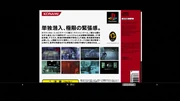
Digital download transmission showing the "dorsum of the package".
On Baronial nine, 2012, Konami Europe stated that, in honor of the 25th Anniversary of the Metal Gear series, the PlayStation Network version of Metal Gear Solid would be sold at a discount of £3.99 instead of £7.99 for ii weeks, starting on August 8.[42] The download versions as well incorporated the front and back of the package with the digital manual, thus allowing for the player to fulfill the mandate of finding Meryl'south frequency.[43]
On December 3, 2018 Sony released the Playstation Classic mini console which included Metal Gear Solid which is included in the 20 games list. Also this game has a save country feature not included in the original release.
Possible 2d remake
In December 2011, Uk Official PlayStation Magazine had a mini interview with Kojima. He stated that "There are a lot of people wanting remakes of the original, and as producer I want to answer those calls", followed by "Merely as a creator I'm not very interested in going dorsum. If we were to practise information technology, it would have to be a total remake – the only thing that would exist the same would be the story. If it happened at some point I would stay every bit a producer, just would have to manus off virtually of the actual creating."[44]
He also added, "I was just making the game I wanted to make. Looking dorsum, in that location's not annihilation in particular I want to get back and fix. If you change anything, you change the game – and I desire to avoid that. If y'all bring the gameplay up to modernistic standards, then you lose a scrap of the original game. It was a game fabricated for a certain era – not simply the story, just the controls and everything well-nigh it reflect that era in which the game was made."[45]
On June 25, 2013, Kojima told Gamereactor that he had a desire to remake Metal Gear Solid with the Flim-flam Engine.[46]
On August thirteen, 2014, Kojima stated that he would consider developing a 2nd remake of Metal Gear Solid. On his Twitch channel, he stated that "personally, I'k not also fond of remakes. Only I would have to go with MGS1. If it was going to be a remake, I wouldn't desire to make a standard remake, but something similar to what Planet of the Apes is doing: Bringing the best of the by to the present and doing something new."[47]
During the 2015 Taipei Game Show, Kojima stated that he would like to run into a remake of Metallic Gear Solid that features an open up world Shadow Moses.[48]
On February 22, 2019 (Nippon fourth dimension), Konami has hinted at possibly making a remake of Metal Gear Solid.[49]
References in other games
Aside from canonical sequels to the game, there is at least one game in the series that featured a non-story reference to it.
In Metallic Gear Solid V: Footing Zeroes, the Metal Gear Solid logo was featured on a wooden wall in the Déjà Vu/Jamais Vu missions. Kazuhira Miller, when doing commentary on the Easter eggs in the game, quoted Otacon'due south "Are you an Otaku, too?" line and also said "If nosotros make it through this, I'll tell yous."[l] The Déjà Vu mission itself also heavily referenced Metal Gear Solid at diverse points, owing to information technology being the tenth ceremony of the game's release.
Reception
| Reviews | |
|---|---|
| Publication | Score |
| Allgame | 5/five |
| Edge | 9/10 |
| GameSpot | 8.5/10 |
| IGN | 9.8/10 |
| NGamer | 9/x |
| Compilations of multiple reviews | |
| Metacritic | 94 out of 100 (based on twenty reviews) |
| GameRankings | 93.75% (based on 28 reviews) |
Metal Gear Solid was a commercial success, shipping over vi million copies worldwide.[2] Upon release, it was one of the well-nigh rented games, and topped sales charts in the United Kingdom.
The game was generally well received by the media and some of the near prominent gaming critics. Users and critics of GamePro gave it an boilerplate score of 4.8 out of 5 calling information technology "this season's height offering [game] and one game no cocky-respecting gamer should be without." However, they criticized the frame rate, saying information technology "occasionally stalls the centre-catching graphics" and "especially annoying are instances where you lot zoom in with binoculars or the rifle scope", and likewise the interruptions of "advice from your squad", in the early parts of the game, "that's listed in the education manual", calling it an "annoyance." GameSpot also criticized this, saying "it needlessly interrupts the game." They also criticized how easy it is for the role player to avoid being seen and its short length and called it "more of a work of art than ... an actual game." Farther criticism came from the website Adrenaline Vault, which said it had "some serious...flaws" which "made it a consummate thwarting."
Information technology received an Excellence Honour for Interactive Art at the 1998 Japan Media Arts Festival. NGamer said "It's like playing a big budget action blockbuster, only amend." IGN said it came "closer to perfection than any other game in PlayStation's activeness genre" and called it "Beautiful, engrossing, and innovative...in every conceivable category."
Metal Gear Solid is recognized past some every bit the start 3D stealth game (Tenchu: Stealth Assassins is actually the first as it was released a few months earlier). The thought of the player being unarmed and having to avoid being seen by enemies, rather than fight them, experienced a resurgence in popularity, and has been featured in many games since. It is likewise sometimes acclaimed as being a moving-picture show equally much equally a game due to the lengthy cut scenes and intricate storyline. Entertainment Weekly said it "broke new ground with...flick-style production...and stealth-driven gameplay, which encouraged...hiding in boxes and crawling across floors." GameTrailers said it "invented the stealth game genre" and called it "captivating, inventive and gritty." The game is widely considered to exist ane of the best PlayStation games, and has featured in numerous greatest video games ever lists by GameFAQs, Japanese magazine Famitsu, Entertainment Weekly, Game Informer, GamePro, Electronic Gaming Monthly, and GameTrailers. However, it'south placing in these lists is inconsistent, ranging anywhere from second to 50th.
In 2002, IGN's editors ranked it every bit the all-time PlayStation game ever. IGN writer David Smith said that just the demo for the game had "more gameplay [in information technology] than in most finished titles." They also gave it the "All-time Ending" and "All-time Villain" awards. In 2005, in placing it 19th on their list of "Elevation 100 Games", saying that it was "a game that truly felt like a motion picture", that the fights were "unique and innovative", and that it was "the founder of the stealth genre."
In other media
Strategy guide
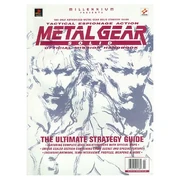
Millennium Books' Metal Gear Solid: Official Mission Handbook.
The strategy guide for the game, titled Metal Gear Solid: Official Mission Handbook, was published by Millennium Books in 1998. The volume was authorized by Konami, including a foreword by Hideo Kojima, and features boosted information on diverse characters and equipment, such as Large Dominate, Decoy Octopus, Sniper Wolf, Liquid Snake, Revolver Ocelot and Ocelot's torture device. It also features interviews with some members of the development staff, including Kojima, a brief overview of the previous games, a plot summary of the MSX2 games, a character relation chart, and an art gallery. Notwithstanding, due to the story developments in later games, it is unclear how much of this information should be considered canon. The volume was written by David S. J. Hodgson, who went on to write many Prima official game guides.
Radio drama
- See Metallic Gear Solid (audio drama)
A Japanese radio drama version of Metal Gear Solid was produced shortly afterwards the release of the original PlayStation game. Directed by Shuyo Murata and written by Motosada Mori, it aired, in xviii segments, from 1998 to 1999 on Konami's Order db program. The serial was later released on CD as a ii book set. Ready after the events of the PlayStation game, Snake, Meryl, Campbell and Mei Ling (all portrayed by their original Japanese voice actors) pursue missions in hostile 3rd world nations as FOXHOUND. Original characters are introduced, such equally Sgt. Allen Iishiba, a Delta Force operative who assists Snake and Meryl; Col. Mark Cortez, an sometime friend of Campbell who commands the fictional Esterian Special Forces; and Capt. Sergei Ivanovich, a former war buddy of Revolver Ocelot from his SVR days.
Comic
- Encounter Metal Gear Solid (comic series)
In September 2004, IDW Publications began publishing a series of Metal Gear Solid comics, written by Kris Oprisko and illustrated by Ashley Woods. 12 problems accept been published, fully covering the game'south storyline.
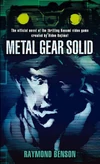
The front embrace of the novelized accommodation.
Novelization
Raymond Benson
A novelization based on the original Metal Gear Solid was written by Raymond Benson and published by Del Rey. The American paperback edition was published on May 27, 2008,[51] with a United kingdom edition released on June 4, 2008. A podcast nearing the release of Metal Gear Solid four also revealed that Hideo Kojima was directly involved in supervising the written work.
In the novelization, Snake seems to have a slightly more perverse, humorous, and almost sarcastic nature than in the original game, eastward.g. responding to Naomi Hunter's offer of a strip search with "WHOA! When practice I offset!?" and ofttimes delivering comedic i liners earlier killing Genome Soldiers. Also, Ophidian seems to kill more than often, such every bit wiping out virtually every baby-sit at the heliport, whereas he has previously been portrayed as sneaking past enemies if possible, rather than fighting them, although Liquid unsaid in the original game equally well as its remake that Snake may have wiped out a majority of Liquid's men also as with some joy.[52] [53]
The novel shed lite on the mysterious Les Enfants Terribles project, stating some of the people involved, and where it took place. Information technology also provides more than information on the death of Master Miller and the true gender of Dr. Clark.[54]
Hitori Nojima
On August 4, 2015, it was announced that Hitori Nojima, the author of the novelization of Metal Gear Solid: Peace Walker, was writing three novelizations, including one, titled Metal Gear Solid Substance I - Shadow Moses, that'south based on the events of Metallic Gear Solid. The book is 544 pages in length. It was released on August 25.[55] [56]
Legacy
Eurodance group Eiffel 65'south song "My Console," which is on their anthology Europop, makes tribute to many hitting PlayStation games, including Metal Gear Solid.
Metal Gear Solid forth with Metallic Gear Solid ii was featured in the Smithsonian American Art Museum's "The Art of Video Games" exhibition from March 16 to September 30, 2012.[57]
"Shadow Moses", a vocal past Bring Me the Horizon on their Sempiternal album, is a reference of the location of the same name.[58]
On December 3, 2018, Metal Gear Solid was released on the PlayStation Classic every bit part of the twenty games list in both the American and Japanese versions.
Gallery
Promotional material
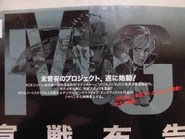
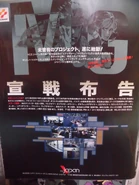
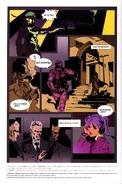
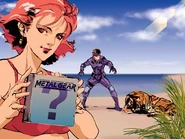
Promotional artwork made for Tokyo Game Evidence 1997. It was meant to deed as a subtle hint towards the game's release engagement (taking place on a declension near the September sea, and having a tiger nearby, the creature for the twelvemonth 1998).
Packaging
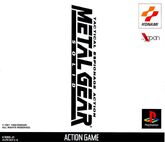
Japanese packaging.
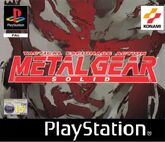
European packaging.
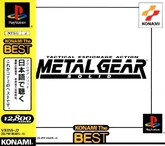
Japanese "Konami The All-time" reprint.
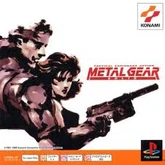
Japanese "PSOne Books" reprint.
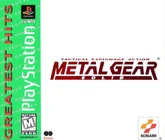
Northward American "Greatest Hits" reprint.
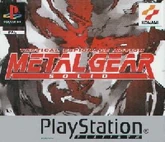
European "Platinum" reprint.
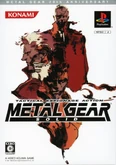
Japanese "20th Anniversary" reprint.
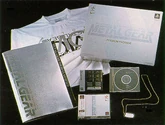
Premium Bundle (Japanese).
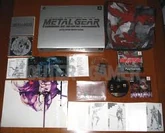
Premium Parcel (European).
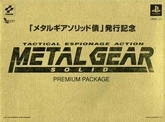
Premium Package (Japanese Stock Holder version).
Demos
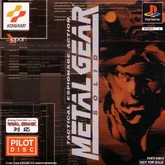
Japanese Pilot Disc (SLPM-80254).
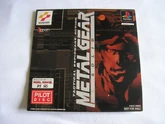
Japanese Airplane pilot Disc (PAPX-90044).
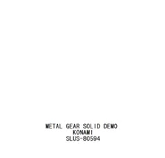
Japanese trade demo.
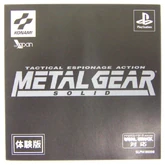
Japanese trail disc (came within Jikkyo Powerful Pro Yakyu).
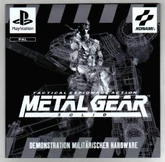
European trail disc (came within ISS Pro '98).
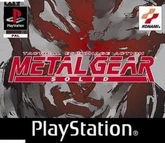
European promo.

North American PiranhaPad demo.
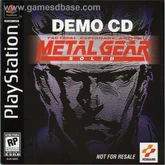
North American demo.
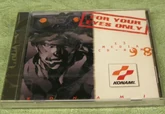
E3 '98 Media CD-ROM.
Books
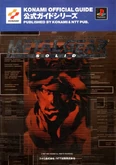
Metal Gear Solid Official Guide.
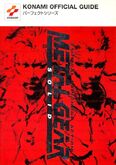
Metal Gear Solid Perfect Guide.
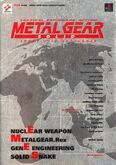
Metal Gear Solid Complete Guide.

Metal Gear Solid Perfect Cheats Guide.
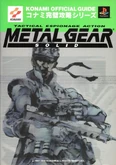
Metallic Gear Solid Official Published Guide.
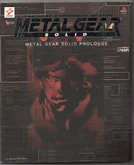
Metallic Gear Solid Prologue.
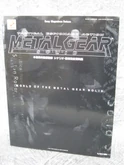
Metallic Gear Solid Scenario Art Material - The Earth of Metal Gear Solid.
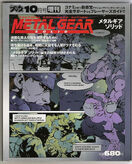
Metallic Gear Solid Back up Guide.
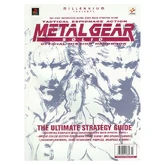
Metal Gear Solid: The Ultimate Strategy Guide.

Metal Gear Solid: The Official Strategy Guide.
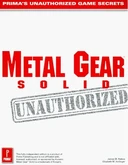
Metal Gear Solid - Unauthorized Prima's Official Strategy Guide.
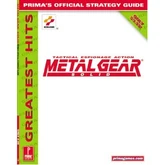
Metallic Gear Solid Greatest Hits - Prima's Official Strategy Guide.

The Art of Metallic Gear Solid.

The Art of Metal Gear Solid one.5.

Metal Gear Solid novel (English language).
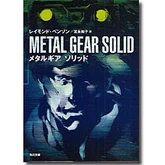
Metal Gear Solid novel (Japanese).

Metal Gear Solid Scenario Volume.
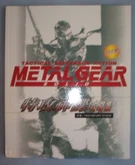
Chinese strategy guide past Yao Yao Fine art Studio (特攻神諜攻略集).
Videos
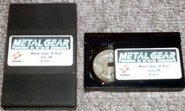
E3 Trailer BETA Tape
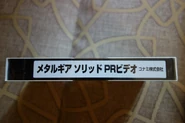
E3 pre-release record.
Merchandise

Action Figures - Solid Snake by McFarlane Toys.

Action Figures - Meryl Sliverburgh past McFarlane Toys.

Activeness Figures - Liquid Snake past McFarlane Toys.

Action Figures - Revolver Ocelot by McFarlane Toys.

Action Figures - Psycho Mantis by McFarlane Toys.

Action Figures - Sniper Wolf by McFarlane Toys.

Action Figures - Vulcan Raven by McFarlane Toys.

Action Figures - Cyborg Ninja by McFarlane Toys.

Activeness Figures - Solid Snake (Stealth) past McFarlane Toys.
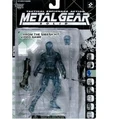
Action Figures - Cyborg Ninja (Stealth) past McFarlane Toys.
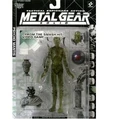
Activeness Figures - Psycho Mantis (Clear) by McFarlane Toys.
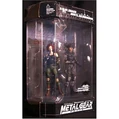
Action Figures - Snake & Meryl double pack by McFarlane Toys.

Action Figures - Toy Off-white '99 Solid Snake by McFarlane Toys.

Action Figures - Toy Fair '99 Solid Snake (Silver) by McFarlane Toys.

Konami Doll Collection - Solid Serpent by Yamato.

Konami Doll Collection - Meryl Sliverburgh past Yamato.

Konami Doll Drove - Liquid Snake past Yamato.

Konami Doll Collection - Sniper Wolf by Yamato.

Trading cards.

Official dog tag necklace by Groovy Eastern Amusement.

Official key chain past Great Eastern Entertainment.

Official necklace by Great Eastern Entertainment.
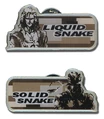
Official pivot badges by Great Eastern Entertainment.

Official stickers sheet by Corking Eastern Entertainment.

Official messenger bag by Nifty Eastern Entertainment.

Official messenger bag by Great Eastern Entertainment.

Official wall coil by Cracking Eastern Entertainment.

Official wall roll by Great Eastern Entertainment.
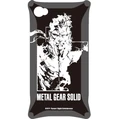
Solid Snake iPhone 4 example (Black) by KONAMISTYLE.
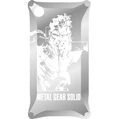
Solid Snake iPhone iv case (Sliver) by KONAMISTYLE.

FOXHOUND iPhone four instance (Black) by KONAMISTYLE.

FOXHOUND iPhone 4 case (Sliver) by KONAMISTYLE.
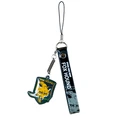
Phone charm by KONAMISTYLE.

FOXHOUND marker primal concatenation by KONAMISTYLE.

FOXHOUND wristband by KONAMISTYLE.

Pin badge past KONAMISTYLE.

Pin badge set up by KONAMISTYLE.
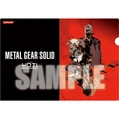
Yoji Shinkawa clear file by KONAMISTYLE.

Tote bag by KONAMISTYLE.

Java mug by KONAMISTYLE.

FOXHOUND cap by KONAMISTYLE.

Official T-shirt by Ripple Junction.

Solid Snake Play Arts KAI activeness figure past Square-Enix Products.

Cyborg Ninja Play Arts KAI activeness effigy by Foursquare-Enix Products.

Cyborg Ninja (Blood-red Version) Play Arts KAI activity figure by Foursquare-Enix Products.
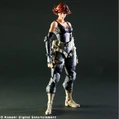
Meryl Silverburgh Play Arts KAI action figure by Square-Enix Products.

Liquid Serpent Play Arts KAI action figure by Square-Enix Products.

Metal Gear REX model kit by Kotobukiya.

Metal Gear Male monarch Black ver. model kit by Kotobukiya.

Prophylactic Keyrings series ane past empty.

Rubber Keyrings series ii by empty.

SDCC 'xiii exclusive golden and silver iPhone 5 cases past KONAMISTYLE.

SDCC '13 exclusive iPhone 5 case by KONAMISTYLE.

Canis familiaris tags by Level Up Clothing.

Cap past Gaya Entertainment.

Wrist band #A by Gaya Entertainment.

Wrist band #B by Gaya Entertainment.

Yoji Shinkawa art print past AOJI. Limited to 500 pieces.

Solid Serpent Nendoroid by GoodSmileCompany.

Solid Snake revolmini by Kaiyodo.
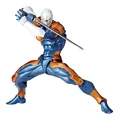
Cyborg Ninja revolmini by Kaiyodo.

Paraphernalia

Promotional pamphlet.

1997 Promotional pamphlet.

E3 1997 brochure.

Promotional fine art book pamphlet.

Promotional trading cards leaflet.

PlayStation Expo 1996 phone card.

Tokyo Game Show 1997 phone carte.

Phone cards set A.

Telephone cards set B.
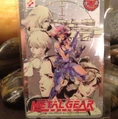
Women of Metal Gear Solid phone card.

Promotional phone card.

Famitsu gift phone bill of fare.

Famitsu limited edition phone card.

Promotional Yoji Shinkawa telephone carte.
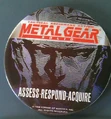
E3 1998 button badge.

Staff presentation folder.

Staff Pencil Pad

Konami staff folder.

Tokyo Game Show 1998 ashtray.

Flask and lighter set.

Light amplification by stimulated emission of radiation pointer.

Cigarette box.

Konami Staff steel watch.
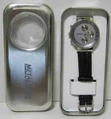
Press release sentinel.

FOXHOUND fossil sentry.

FOXHOUND Zippo lighter.

Nada lighter, keyring and booklet ready.

Pin badge drove.

Promotional logo pin badge.

FOXHOUND pin badge.

Commemorative vino.

Reservation postcard fix (gold).

Reservation postcard set (sliver).

PlayStation memory card.
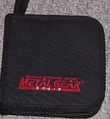
CD case.

FOXHOUND militia hat.

PlayStation menu drove.

Wallscroll.

Notebook.

MGS survival kit (includes binoculars, survival pocketknife, and compass carabiner).
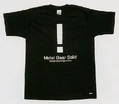
Tokyo Game Show 1999 t-shirt.

N America pre-guild T-shirt.

Promo T-shirt.

Promo T-shirt.

Promo T-shirt.

Promo lanyard.

Promotional SDCC 2011 Adventure headband.

Promotional key chain.
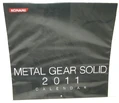
Promotional 2011 calender.
Posters & wallpaper
Trailers

Metal Gear Solid E3 1996 Trailer - Concept
Metal Gear Solid E3 1996 trailer.

Metal Gear Solid trailer (E3 1997)
Metal Gear Solid E3 1997 trailer.

Metal Gear Solid TGS 1997 Trailer
Metal Gear Solid TGS 1997 trailer.
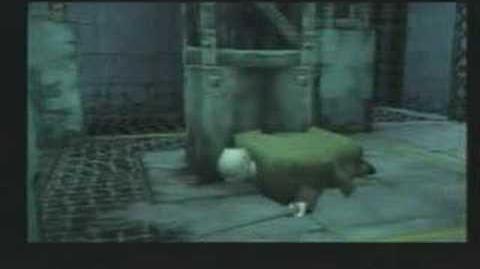
Metal Gear Solid TGS 1998 Trailer
Metallic Gear Solid TGS 1998 trailer.

Metal Gear Solid - Suicide Mission - Hilarious!
Suicide Mission trailer for MGS.

Metallic Gear Solid Japanese CM

Metallic Gear Solid Japanese CM ii
External links
- Instruction transmission
See also
| Walkthrough Alert! |
| We have a walkthrough for this game. Click here to view it |
- Solid Snake
- Listing of Metal Gear Solid bosses
- Metal Gear Solid secrets
- Graphic symbol Gallery/Metal Gear Solid
- Similarities between games
References
Metal Gear has a special feeling Metal Gear is quite an old game. Why did you decide to brand a sequel after all this time? Hideo Kojima: Metallic Gear came out in 1987. Has it really been ten years? The truth is that Metallic Gear was actually the starting time game that I've made when I've joined Konami. In that location'due south that emotional attachment, too as a feeling of tension of "being seen or not by the enemy" that was characteristic of Metallic Gear that I wanted to explore farther. For example, let'south say your character hides nether a desk. When that happens, the betoken of view changes to nether the desk and the nearby soldiers will walk effectually making noises. Or yous hear the footsteps of a soldier, so you lot apace hide inside a locker to avoid making noises. I wanted to express that kind of tension. I had the aforementioned concept with the original Metallic Gear, just I wasn't able to express it with the hardware bachelor at the time. However, we finally have a 32-bit console capable of using many polygons, and so I can finally practice what I wanted to.
Kojima: Yes, that's correct. But I started working on it a bit late since we did Policenauts start. (laughs)
Kojima: At the time I wasn't thinking of 3D, so I did the best I could under those circumstances. Since 3D is possible, on ane hand y'all can now do this and that and anything, but in dissimilarity everything is now harder to make. (laughs)
Kojima: It'south a new type of Metallic Gear. To exist honest, I don't call up almost modern players are even enlightened of the original Metal Gear. And so I wanted to remake Metallic Gear so that people could play it again. (laughs)
Kojima: It's a polygon-based 3D action game. The basic idea is to infiltrate an enemy fortress where guards are roaming and you lot must continue while avoiding being spotted by the enemy as much as possible and avoid all sorts of traps.
Kojima: That'southward the idea. If you become spotted past an enemy, he volition chosen for fill-in with a radio or something. Withal, if all you lot practice throughout the game is simply hide from the enemy, then it'll be quite a stressful feel, so there are instances where y'all must fight a boss-class enemy in a fancy showdown. I wanted to continue a careful rest betwixt tension and combat.
Kojima: Comparisons to Resident Evil seems to be unavoidable based on its appearance. (laughs) However, I retrieve you will experience a completely different sense of heart-pounding excitement in Metallic Gear Solid. There won't be such thing as having to readjust to the controls because the perspective has been changed. Basically your perspective remains the same throughout the game and your grapheme volition ever become upwards when you press up on the directional pad. I wanted to realize a unproblematic and efficient control system for players who accept never played a 3D game before without making them feel out-of-place. Menu-driven or action-based? That's the only difference
Kojima: The hero of the game is a mercenary named Solid Serpent, who also appeared in the original Metal Gear and its sequel Metallic Gear 2. The setting is a nuclear weapons storage facility owned past the U.S. war machine located in Alaska that has been hijacked by special forces group called Play a trick on HOUND. That's the reason why Ophidian has been sent there. From his perspective, information technology'southward a boxing between himself and the members of the special forces grouping he used to belonged to.
Kojima: That's right. I'yard very obsessive when it comes to making such things. In other words, Metal Gear Solid is pretty much the same equally Snatcher and Policenauts, even if the method of unraveling the story is different. The themes I want players to feel is the same whether the story is unraveled by action-based gameplay or by navigating through menus. Still, I think the players is able to understand more than if at that place is some action-based gameplay. On the other hand, action-based gameplay alone will go in the style of the story, so regulating that is difficult.
Kojima: Having to adjust that balance seems to be the most difficult function. I want to employ move and photographic camera piece of work well and show things without feeling out of place. I desire to testify for example, a startling move that causes a sudden noise, naturally in 1 flow. While we use movement capturing, we also have a staff member who worked every bit an animation for almost a decade and his handmade animations is pretty squeamish as well. Yous can create something squeamish if you lot know how to use these things well. Regarding camera piece of work, the composition will not change much and nosotros will oft use cinematic techniques in which the photographic camera moves in or abroad. Pre-rendered videos won't exist used much. We might used them to cut-in an image, only the actual events will exist rendered in polygons. For that purpose, each character volition have around 3 or four models.
Kojima: Suppose you're projecting a graphic symbol from a distance. If the camera moves closer to the graphic symbol, the character model will get rougher equally its gets close. In guild to avoid this, we supplant the character model with a version that has more than polygons as the photographic camera approaches the grapheme. This is a technique often used in movies for visual effects.
Kojima: The more realistic your worldview is, the more than important such a thing volition exist. Only pre-rendered videos take their merits likewise. You desire to throw-in a video considering it'due south easier to express subtler furnishings that way.
Kojima: I wanted to make a hardboiled world. And I wanted to demonstrate it equally amusement. Since we utilise war as a motif, there'south some heroic parts. You have your guns blazing, shooting at bad guys. Yous are cool, you are a hero, you're that sort-of guy. However, if all that remains are only stuff that was cool, and then I really wouldn't phone call that "amusement." I want players to exist witting of what war ways and what is a nuclear weapon by the time they're done watching ending.
Solid Serpent: I don't want that kind of world! // Liquid Snake: Ha! You lie! So why are you here and then? Why do y'all continue to follow your orders while your superiors betray you? Why did you come hither? // Solid Snake: ...... // Liquid Snake: Well... I'll tell you lot and so. Yous enjoy all the killing, that's why. // Solid Serpent: What! // Liquid Snake: Are you denying it? Haven't you already killed most of my comrades? // Solid Snake: That was... // Liquid Serpent: I watched your face when y'all did it. It was filled with the joy of battle. [...] That's right... The Genome Soldiers that you've [Solid Snake] been killing are our brothers, with the aforementioned genes as ours.
Solid Ophidian: I don't want that kind of world! // Liquid Serpent: Ha! You lie! So why are you hither then? Why practice you continue to follow your orders while your superiors beguile you? Why did you come here? // Solid Serpent: ...... // Liquid Snake: Well... I'll tell you then. Y'all enjoy all the killing, that'due south why. // Solid Snake: What! // Liquid Snake: Are you denying it? Oasis't you lot already killed well-nigh of my men? // Solid Snake: That was... // (blood-red-toned flashback to Ophidian killing a Genome soldier) // Liquid Ophidian: I saw the look on your confront. It was filled with such vitality. [...] That's right... The Genome Soldiers that y'all've [Solid Serpent] been killing left and correct are our brothers, with the aforementioned genes every bit ours.
External links
- Official website (Japanese)
- Original official website (Japanese, Waybacked)
- Metal Gear Solid on Moby Games
- Metallic Gear Solid on GameFAQs
DOWNLOAD HERE
Metal Gear Solid 1 Do Solidiers Comentary Change on Account of How Well You Do UPDATED
Posted by: patriciabacee1941.blogspot.com